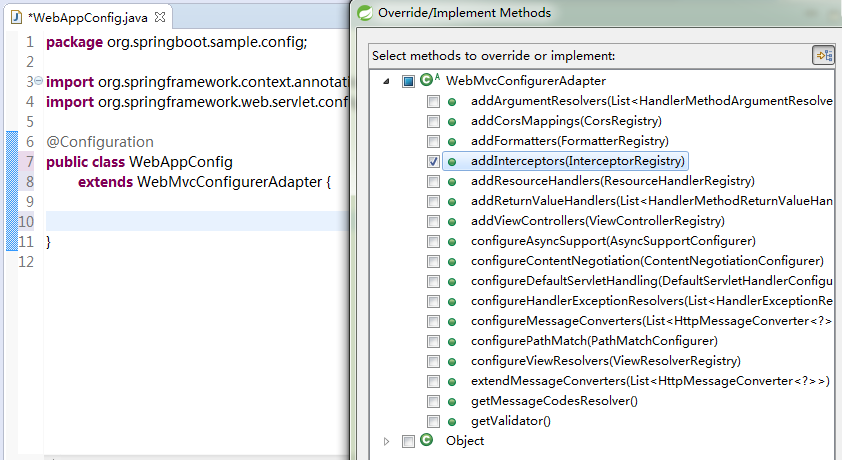- 1nc网络收发测试-tcp客户端\TCP服务器\UDP\UDP广播
- 2一文带你读懂JDK源码:Lambda表达式
- 3基于FPGA的简单数字钟设计VHDL代码Quartus仿真_24进制计数器vhdl代码
- 4Ai人工智能的技术栈_人工智能技术栈
- 5基于微信小程序的校园综合服务平台
- 6docker swarm 搭建 elasticsearch 集群_docker elasticsearch配置 swarm
- 7MaxCompute(ODPS):Hive的进阶者_odps和hive
- 8听龙华讲公共组件 CBB 建设笔记_软件cbb
- 9【爱空间_登录安全分析报告】
- 10前来挑战!应急响应靶机训练-Web3_前景需要:小苕在省护值守中,在灵机一动情况下把设备停掉了,甲方问:为什么要停设备
Spring Boot 拦截器_springmvc referer限制
赞
踩
上一篇对过滤器的定义做了说明,也比较简单。过滤器属于Servlet范畴的API,与Spring 没什么关系。
Web开发中,我们除了使用 Filter 来过滤请web求外,还可以使用Spring提供的HandlerInterceptor(拦截器)。
HandlerInterceptor 的功能跟过滤器类似,但是提供更精细的的控制能力:在request被响应之前、request被响应之后、视图渲染之前以及request全部结束之后。我们不能通过拦截器修改request内容,但是可以通过抛出异常(或者返回false)来暂停request的执行。
实现 UserRoleAuthorizationInterceptor 的拦截器有:
ConversionServiceExposingInterceptor
CorsInterceptor
LocaleChangeInterceptor
PathExposingHandlerInterceptor
ResourceUrlProviderExposingInterceptor
ThemeChangeInterceptor
UriTemplateVariablesHandlerInterceptor
UserRoleAuthorizationInterceptor
其中 LocaleChangeInterceptor 和 ThemeChangeInterceptor 比较常用。
配置拦截器也很简单,Spring 为什么提供了基础类WebMvcConfigurerAdapter ,我们只需要重写 addInterceptors 方法添加注册拦截器。
实现自定义拦截器只需要3步:
1、创建我们自己的拦截器类并实现 HandlerInterceptor 接口。
2、创建一个Java类继承WebMvcConfigurerAdapter,并重写 addInterceptors 方法。
2、实例化我们自定义的拦截器,然后将对像手动添加到拦截器链中(在addInterceptors方法中添加)。
PS:本文重点在如何在Spring-Boot中使用拦截器,关于拦截器的原理请大家查阅资料了解。
代码示例:
MyInterceptor1.java
package org.springboot.sample.interceptor; import javax.servlet.http.HttpServletRequest; import javax.servlet.http.HttpServletResponse; import org.springframework.web.servlet.HandlerInterceptor; import org.springframework.web.servlet.ModelAndView; /** * 自定义拦截器1 * * @author 单红宇(365384722) * @myblog http://blog.csdn.net/catoop/ * @create 2016年1月7日 */ public class MyInterceptor1 implements HandlerInterceptor { @Override public boolean preHandle(HttpServletRequest request, HttpServletResponse response, Object handler) throws Exception { System.out.println(">>>MyInterceptor1>>>>>>>在请求处理之前进行调用(Controller方法调用之前)"); return true;// 只有返回true才会继续向下执行,返回false取消当前请求 } @Override public void postHandle(HttpServletRequest request, HttpServletResponse response, Object handler, ModelAndView modelAndView) throws Exception { System.out.println(">>>MyInterceptor1>>>>>>>请求处理之后进行调用,但是在视图被渲染之前(Controller方法调用之后)"); } @Override public void afterCompletion(HttpServletRequest request, HttpServletResponse response, Object handler, Exception ex) throws Exception { System.out.println(">>>MyInterceptor1>>>>>>>在整个请求结束之后被调用,也就是在DispatcherServlet 渲染了对应的视图之后执行(主要是用于进行资源清理工作)"); } }
- 1
- 2
- 3
- 4
- 5
- 6
- 7
- 8
- 9
- 10
- 11
- 12
- 13
- 14
- 15
- 16
- 17
- 18
- 19
- 20
- 21
- 22
- 23
- 24
- 25
- 26
- 27
- 28
- 29
- 30
- 31
- 32
- 33
- 34
- 35
- 36
- 37
- 38
- 39
MyInterceptor2.java
package org.springboot.sample.interceptor; import javax.servlet.http.HttpServletRequest; import javax.servlet.http.HttpServletResponse; import org.springframework.web.servlet.HandlerInterceptor; import org.springframework.web.servlet.ModelAndView; /** * 自定义拦截器2 * * @author 单红宇(365384722) * @myblog http://blog.csdn.net/catoop/ * @create 2016年1月7日 */ public class MyInterceptor2 implements HandlerInterceptor { @Override public boolean preHandle(HttpServletRequest request, HttpServletResponse response, Object handler) throws Exception { System.out.println(">>>MyInterceptor2>>>>>>>在请求处理之前进行调用(Controller方法调用之前)"); return true;// 只有返回true才会继续向下执行,返回false取消当前请求 } @Override public void postHandle(HttpServletRequest request, HttpServletResponse response, Object handler, ModelAndView modelAndView) throws Exception { System.out.println(">>>MyInterceptor2>>>>>>>请求处理之后进行调用,但是在视图被渲染之前(Controller方法调用之后)"); } @Override public void afterCompletion(HttpServletRequest request, HttpServletResponse response, Object handler, Exception ex) throws Exception { System.out.println(">>>MyInterceptor2>>>>>>>在整个请求结束之后被调用,也就是在DispatcherServlet 渲染了对应的视图之后执行(主要是用于进行资源清理工作)"); } }
- 1
- 2
- 3
- 4
- 5
- 6
- 7
- 8
- 9
- 10
- 11
- 12
- 13
- 14
- 15
- 16
- 17
- 18
- 19
- 20
- 21
- 22
- 23
- 24
- 25
- 26
- 27
- 28
- 29
- 30
- 31
- 32
- 33
- 34
- 35
- 36
- 37
- 38
- 39
MyWebAppConfigurer.java
package org.springboot.sample.config; import org.springboot.sample.interceptor.MyInterceptor1; import org.springboot.sample.interceptor.MyInterceptor2; import org.springframework.context.annotation.Configuration; import org.springframework.web.servlet.config.annotation.InterceptorRegistry; import org.springframework.web.servlet.config.annotation.WebMvcConfigurerAdapter; @Configuration public class MyWebAppConfigurer extends WebMvcConfigurerAdapter { // 这里注意,在spring 5.0之后 WebMvcConfigurerAdapter 过时了,可以直接实现接口 implements WebMvcConfigurer(下面实现的方法是一样的) @Override public void addInterceptors(InterceptorRegistry registry) { // 多个拦截器组成一个拦截器链 // addPathPatterns 用于添加拦截规则 // excludePathPatterns 用户排除拦截 registry.addInterceptor(new MyInterceptor1()).addPathPatterns("/**"); registry.addInterceptor(new MyInterceptor2()).addPathPatterns("/**"); super.addInterceptors(registry); } }
- 1
- 2
- 3
- 4
- 5
- 6
- 7
- 8
- 9
- 10
- 11
- 12
- 13
- 14
- 15
- 16
- 17
- 18
- 19
- 20
- 21
- 22
- 23
- 24
然后在浏览器输入地址: http://localhost:8080/index 后,控制台的输出为:
>>>MyInterceptor1>>>>>>>在请求处理之前进行调用(Controller方法调用之前)
>>>MyInterceptor2>>>>>>>在请求处理之前进行调用(Controller方法调用之前)
>>>MyInterceptor2>>>>>>>请求处理之后进行调用,但是在视图被渲染之前(Controller方法调用之后)
>>>MyInterceptor1>>>>>>>请求处理之后进行调用,但是在视图被渲染之前(Controller方法调用之后)
>>>MyInterceptor2>>>>>>>在整个请求结束之后被调用,也就是在DispatcherServlet 渲染了对应的视图之后执行(主要是用于进行资源清理工作)
>>>MyInterceptor1>>>>>>>在整个请求结束之后被调用,也就是在DispatcherServlet 渲染了对应的视图之后执行(主要是用于进行资源清理工作)
- 1
- 2
- 3
- 4
- 5
- 6
根据输出可以了解拦截器链的执行顺序(具体原理介绍,大家找度娘一问便知)
最后强调一点:只有经过DispatcherServlet 的请求,才会走拦截器链,我们自定义的Servlet 请求是不会被拦截的,比如我们自定义的Servlet地址 http://localhost:8080/xs/myservlet 是不会被拦截器拦截的。并且不管是属于哪个Servlet 只要复合过滤器的过滤规则,过滤器都会拦截。
最后说明下,我们上面用到的 WebMvcConfigurerAdapter 并非只是注册添加拦截器使用,其顾名思义是做Web配置用的,它还可以有很多其他作用,通过下面截图便可以大概了解,具体每个方法都是干什么用的,留给大家自己研究(其实都大同小异也很简单)。






